January 24, 2014
Vol.16 Japanese Leather - Full of Surprises!
By Alice Gordenker

Recently a friend from Los Angeles visited me here in Japan. I helped her explore Tokyo and we made an overnight trip to Kyoto just when the fall colors were at their peak. The day before she returned to the U.S. she gave me a gift to thank me.
The gift was a small coin purse made of black leather. I held it in my hand. The leather was very smooth and soft to the touch, so I could tell it was of good quality, but there was nothing special about the purse itself. It had no pattern or texture. The design was very plain. To be honest, I felt a little disappointed at how uninteresting it was.
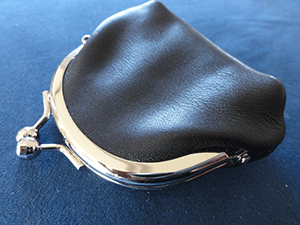
Then I opened the purse and got a big surprise. On the inside, the coin purse was bright and colorful, in total contrast to the outside. The cloth inside the purse was of a bright, busy pattern in vivid colors like magenta, yellow and blue.
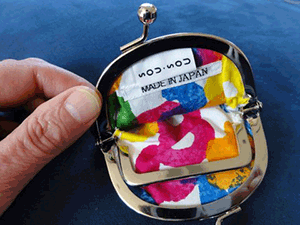
My friend laughed. "I choose this coin purse because it's just like you - quiet on the outside but wild on the inside!" A big smile broke out on my face because what she said was so clever - and true! The purse was made by Sou Sou, a trendy Kyoto fashion company internationally known for its tabi shoes in bright and unusual fabrics.
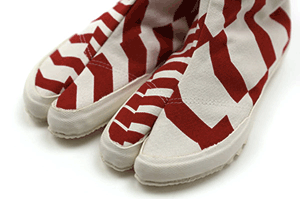
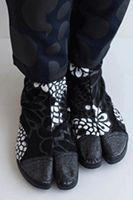
In the end, I felt very pleased with the gift because it was both clever and thoughtfully chosen. Aren't those the gifts that we remember best?
As my friend was packing, we talked about her visit and her impressions of Japan. "What I like best about Japan is how surprising it is," she said. "Everywhere I went I saw something new and interesting. For me, Japan is exciting and full of new discoveries."
I remembered those words when I sat down to write this essay. Most first-time visitors to Japan don't expect to find attractive leather products. They definitely don't come looking for leather, as they might if they were visiting Italy or Brazil. Japan is famous for many things, including beauty and function and quality, but it's not famous for leather.
Still, if foreign visitors happen to encounter leather products in Japan, they will be drawn to them if the products meet their expectations. People expect something "Made in Japan," to be beautiful, functional and of high quality. But to make foreign visitors not just admire but also buy Japanese leather goods, I think one more thing is necessary - the products should be surprising.
What, exactly, do I mean by "surprising?" Actually, my little coin purse is a perfect example. It is surprising because of the unexpectedly colorful pattern on the inside. A product can surprise by being unique, playful or delightful.
Here are some examples of Japanese leather products that I find surprising:
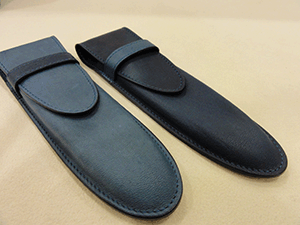
These beautiful pen cases are made in Tokushima Prefecture from leather dyed with the traditional "Aizome" dying technique normally used only for cloth. You probably can't find leather in these colors anywhere else in the world, which is why the company rightfully calls this product line, which also includes wallets and key holders, as its "Japan Blue Leather" series. (Kinuya.)

This elegant little party bag seems to be covered with jewels so you'd expect it to be quite heavy. But it's actually surprisingly light. That's because the leather is made by applying a special film to pigskin, for a look that is both substantial and classy. The metal work is done by skilled Japanese craftsmen, and the chain can be concealed inside to convert the bag from a handbag to a clutch. It's a perfect combination of traditional craftsmanship, new technology, function and beauty. (Hirata Fukuromono Kogei.)
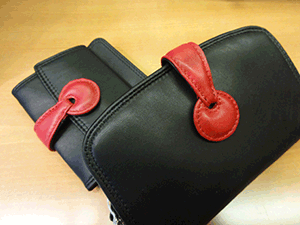
When I visited the Tanizawa showroom in Ginza, my eye was immediately drawn to these black wallets with their dramatic red trim. They are made of incredibly soft lambskin that just begs to be touched, but it is also the richness of the colors, as well as the color contrast, that makes them so delightful. (Tanizawa Ginza.)
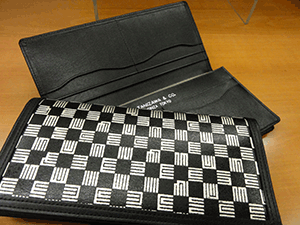
Another unique find in the Tanizawa store was this wallet made using traditional lacquer-on-leather techniques. Craftsmen in Kyoto apply lacquer to leather and, while the lacquer is still wet, apply thin strips of silver on top. The effect is very elegant and very Japanese. There are various products and colors in this series, which is called "Genji-ko." (Tanizawa Ginza.)

Finally, I love these "Sabi" handbags made from hand-dyed leather. "Sabi" means "rust," but in aesthetic terms, it also means a desirable imperfection (often expressed with the term "wabi-sabi.") As part of the dying process, craftsmen set metal objects on treated leather and let the chemical reaction create one-of-a-kind patterns of color and shading. (Princess Bag)
Japanese leather goods can compete in the world market by offering something different. Beauty, function and quality are musts - but companies will do best when they also offer something that can delight and surprise.

Alice Gordenker is an American who has lived in Japan for more than 15 years. A long-term columnist for The Japan Times, she writes regularly about Japan in English. She is quiet on the outside but wild on the inside.

How Japanese Leather products are perceived by foreigners living in
Japan and Japanese overseas?
“Mekakushi” from outside may shed a light on and help you open the eyes
to the undiscovered.
- Vol.16 Japanese Leather - Full of Surprises!
- Vol.15 Leather goods of South Africa have taken root in my life
- Vol.14 Traveling life lightly: A Permaculture Designer's experience with Japanese leather
- Vol.13 As tough as leather
- Vol.12 In France, taking off shoes is the same as taking off clothes
- Vol.11 In Praise of Pen Cases
- Vol.10 Japanese leather products in the eyes of an English gentleman
- Vol.9 Awareness for leather product
- Vol.8 The appeals of the leather bags made in Japan
- Vol.7 From the smell of leather―To those nostalgic days
- vol.6 Mainland shoppers towards Leather Products
- Vol.5 Readily Available or a luxury- the leather culture difference between Korea and Japan.
- vol.4 Japan Leather Award 2011
- Vol.3 Professional Pride in Monozukuri
- Vol.2 My first encounter with Japanese leather
- Vol.1 Hidden Treasure










